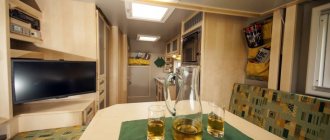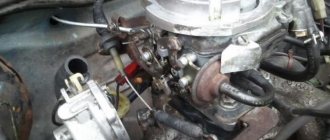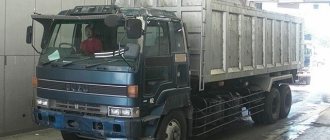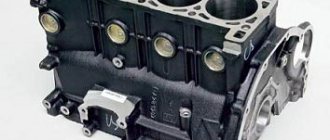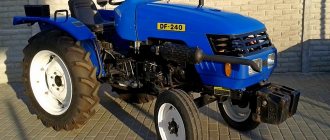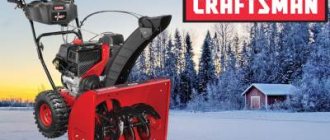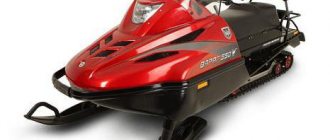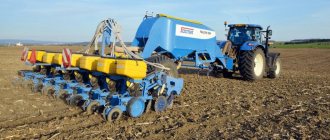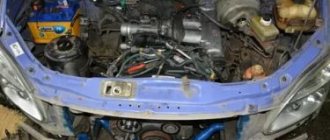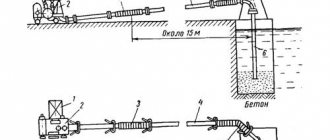Motor vehicle
| Unimog 404 | |
| German fire truck based on Unimog 404.1 TLF 8/8 | |
| Review | |
| Type | Truck |
| Manufacturer | Daimler-Benz AG |
| Also called | 404.1: Unimog U82 404.0 : Unimog U110 |
| Production | 1955-1980 |
| assembly | Mercedes-Benz-Werk Gaggenau |
| Transmission | |
| Engine |
|
| Transmission of infection | 6-speed manual transmission with 2 additional reverse gears |
| Chronology | |
| Predecessor | nobody |
| Successor | Unimog 435 [1] |
Unimog 404
, also called
Unimog S
and
Unimog 404 S
, is a vehicle from the Unimog-series from Mercedes-Benz, produced at the Unimog plant in Gaggenau from 1955 to 1980. Sold as the
Unimog U82
and later
the Unimog U110
, 64,242 two Unimogs were built 404 types
404.0
and
404.1
, making the 404 the highest production Unimog of all Unimogs. [2] Unlike the Unimog 401, the 404 is a small 1.5 tonne SUV rather than an agricultural vehicle. In Germany it was a common [3] military vehicle and fire engine, 36,000 [4] Unimog 404s were manufactured for the Bundeswehr. [5]
The first Unimog 404 concept car was produced in 1953 and was slightly smaller than the production model, with a track width of 1,600 mm (63 in) and a wheelbase of 2,670 mm (105 in). Two prototypes for the French Army followed in 1954, and the first 1,100 production models were also purchased by the French Army. [5] Because the French Army did not want the spare tire to take up space for soldiers on the bed, Daimler-Benz engineers decided to build the Unimog 404 with a drop-down frame so that the spare tire could be mounted under the bed. This design feature also allowed for increased torsional flex and therefore improved the Unimog's off-road capabilities. Later, the downward-facing frame became a key design feature for subsequent types of Unimog. [6]
At the time of its introduction in 1955, the Unimog 404.1
was available with a 2,700 mm (106 in) wheelbase, powered by a 60 kW (80 hp) Otto M 180 engine.
in)
wheelbase 404.1 followed in 1956 , available with the same engine.
Both were sold as Unimog U82
.
Production of the short wheelbase U82 ceased in 1971, with the long wheelbase model in production until 1980. From 1971 the Unimog 404.0
, marketed as
the Unimog U110
.
It was equipped with a Unimog 406 cab and soon after, with model 404.012, it received the M 130 engine. However, only 1,791,404.0 were
made.
Additionally, 81 Unimog 404 were produced with the OM 615 diesel engine (44 kW (59 hp; 60 bhp)) for the Portuguese market. [2] The Unimog 404.0 has the cab of the Unimog 406.
Types of model range and areas of application
Today, trucks of this brand are distinguished by unsurpassed cross-country ability, reliability and efficiency.
Traditionally, impeccable build quality, high performance characteristics, compliance with environmental standards and driver comfort at work constitute the main advantages of this type of equipment.
Design features (high ground clearance, flexible roll-up frame) provide excellent all-terrain qualities of these trucks. So, overcoming an ascent angle of 45° or a ford 1.2 m deep is not a problem for vehicles of this category.
Trucks of this model range are available in 3 modifications:
- Heavy Series 437 (UHN). These include the U 4000 and U 5000 models, designed for off-road driving.
- The average series 405 (UGN), which is the most popular due to the ability to install attachments for a wide range of purposes. Representatives of this line are the U 300, U 400 and U 500 trucks.
- The light series is represented by the U 20 model, designed specifically for left-hand traffic and is a modified version of the U 300.
The ability to mount a variety of attachments and trouble-free operation in a wide range of climatic conditions on any type of soil make trucks of this series universally in demand.
On the basis of the Unimog line, military, municipal, agricultural and construction equipment is produced, as well as locomotives with guides for movement on railway tracks.
In Russia, the so-called VIP-class “motorhomes” are especially popular, especially revered by fans of outdoor activities and hunting enthusiasts.
Model range in the table
Unimog models are usually divided into several series:
- early generations 401/402 and improved 411, produced until 1975;
- the first version with all-wheel drive 404, which lasted on the assembly line until 1980;
- the 406 family (including models 416, 426, 419, 403, 413, 421 and 431), which were assembled until the early 90s;
- light series LBU (407 and 408);
- medium MBU series (417 and 418);
- heavy series SBU (424, 425, 435 and subsequent - 427, 436 and 437);
- series for extreme road conditions 437.4, produced in the 2000s.
First generation
The first generation is usually understood as the LBU, MBU and SBU series, assembled in the 90s. last century.
The characteristics of the machines are given in the table.
| Parameter | 408 | 418 | 427 |
| Length, m | up to 5.07 | up to 5.623 | up to 6.1 |
| Width, m | 1,912 | 2,096 | 2,3 |
| Height, m | up to 2.59 | up to 2.67 | 2,875 |
| Base, m | 2.69 or 3.22 | 2.83 or 3.9 | from 3.25 to 3.85 |
| Turning radius, m | 11.2 or 13.3 | 12.0 or 13.85 | — |
Second generation
The characteristics of the machines are given in the table.
| Parameter | U216 | U323 | U427 | U530 long |
| Wheelbase, mm | 2800 | 3000 | 3150 | 3900 |
| Permissible total weight, t | 10,0 | 13,8 | 14.0 | 16,5 |
| Turning diameter, m | 12,6 | 13,7 | 14.3 | 16,9 |
| Length, m | 4,9 | 5,1 | 5,15 | 6,2 |
| Width, m | 2,15 | 2,2 | 2,2 | 2,3 |
| Height, m | 2,82 | 2,9 | 2,9 | 2,97 |
| Maximum speed, km/h | 89 | 89 | 89 | 89 |
In addition, special regional Unimog models are produced.
The equipment is supplied to the markets of developing countries with left-hand traffic.
Review of episode 404[edit]
Types of Unimog 404 [8]
| Type number | 404-type | Production period | Taxi | Wheelbase (mm) | Motor power (kW) | engine's type | Number of produced | Notes |
| 404.010 [9] | 404,0 | Cabriolet | 2900 | 81 years old | M 130 | 113 | Unimog 416 cab, [10] some units with M 180, 60 kW [11] | |
| 404.011[12] | 404.0 | Closed cab | 2900 | 81 | M 130 | 1151 | Cab of the Unimog 406[10] | |
| 404.012[13] | 404.0 | Cabrio | 2900 | 81 | M 130 | 7 | Cab of the 416[10] | |
| 404.013[14] | 404.0 | Closed cab | 2900 | 81 | M 130 | 520 | Cab of the 406[10] | |
| 404.111[15] | 404.1 | 1955–1956 | Cabrio | 2670 | 63 | M 180 | 1210 | Including 578 pre-series models,[16] some units with 59 or 60 kW. |
| 404.112[17] | 404.1 | Cabrio and closed cab | 2900 | 60 | M 180 | 185 | ||
| 404.113[18] | 404.1 | Cabrio and closed cab | 2900 | 60 | M 180 | 8106 | Some vehicles with 68 or 81 kW[19] | |
| 404.114[20] | 404.1 | 1956–1980 | Cabrio, chassis only and double cab | 2900 | 60 | M 180 | 50321 | Some vehicles also with 68 kW |
| 404.115[21] | 404.1 | Closed cab | 2900 | 60 | M 180 | 2548 | Some vehicles also with 68 kW | |
| 404.117[22] | 404.1 | 1969–1970[19] | Cabrio | 2900 | 44 | OM 615 | 81 | Model for the Protuguese market |
Equipment characteristics
Main technical characteristics (using the example of the U423T railway modification):
- engine power - 231 hp. With.;
- environmental class - Euro 5 or 6;
- permissible total weight - up to 13 tons;
- length - 5.5 m;
- width - 2.3 m;
- height - 3.0 m;
- wheelbase - 3.0 m;
- highway speed - up to 90 km/h;
- speed on rails (with load) - up to 25 km/h;
- permissible trailer weight of the train is up to 1000 tons.
Railway modifications differ from standard ones by the installation of a special air compressor, which ensures the operation of the braking system of the cars. The design of the chassis includes runner wheels with an adjustable track, ensuring that the machine is kept on the rails. Automatic railway couplers are mounted on the frame, and there are outlets for connecting hoses of the pneumatic brake system. The equipment is painted bright yellow, and orange flashing lights and an audible signal are placed on the roof of the cab.
Exterior and interior of Mercedes
The Unimog has an angular design. Located above the front axle, the cabin has a larger windshield area, providing an improved view of the road from the driver's seat. Fuel tanks and a urea reservoir are located on the sidewalls of the side members, and protection against damage to the tanks is provided. The driver enters the cabin through a hinged door; there are steps on the front fender.
The cars use a cabin with an asymmetrical shortened hood and a flat floor, in which driver and passenger seats are installed, separated by a power unit casing. The driver's seat is adjustable in several directions, and the position of the steering column can be adjusted in 2 planes. Upon request, the seat is mounted on a pneumatic support, which reduces vibration levels. The steering wheel is equipped with additional buttons for controlling auxiliary systems. To increase the level of comfort, air conditioning and heating are provided.
Motors used
The Unimog vehicles produced in 2022 use 4- and 6-cylinder diesel engines of the OM 934 or OM 936 models with a variable charging system, developing power up to 299 hp. With. The motors are equipped with a forced liquid cooling system. To reduce exhaust toxicity, a urea injection unit is installed (a separate tank is provided for storing the AdBlue reagent supply).
For example, the U400 model was equipped with a 238-horsepower engine that complies with Euro-3 toxicity standards. There is a supercharger driven by the exhaust gas flow. The manufacturer claims the ability to start the engine at temperatures from -18°C without additional air heating. The U4000 model was equipped with a 177-horsepower OM904LA unit, and the U5023 was equipped with a 300-horsepower modification. With.
The units are equipped with a dry clutch with 1 disc; a pedal located at the driver’s seat is used for control. The transmission includes a gearbox with a built-in transfer gearbox that evenly distributes torque between the axles. To control the box, a lever located on the central tunnel in the cabin is used. The transmission allows the vehicle to accelerate to 90 km/h (civilian versions can reach speeds of up to 110 km/h). Railway modifications are equipped with a hydromechanical transmission.
Steering part
The steering is of a hydraulic type, the drives to the rotary hubs are routed inside the portal-type axles. On some vehicles, it was possible to reinstall the steering column on the sides of the cab (depending on the work being performed). The hydraulic system pump is driven by the power unit; the fluid pressure in the circuits reaches up to 170 bar.
Brake system
The braking system includes disc brakes with pneumatic drive. The source of compressed air is a compressor installed on the engine cylinder block. The system is divided into circuits, there is an anti-lock braking system ABS with an electronic force distribution function (taking into account the load). When operating in off-road conditions, the unit is switched off or switched to a special operating mode that provides improved cross-country ability.
The most famous models
In the age of high speeds, it is easy to buy a low-speed, but highly cross-country car or motorcycle in a specialized store.
The following are in particular demand among connoisseurs:
- GAZ-71;
- ZIL-5901;
- NAMI-0127;
- Kharkov resident;
- DT-10;
- KamAZ engine;
- TREKOL-39294;
- Leopard;
- Vodnik;
- Chastener;
- Viking;
- Shaman 8*8;
- TM-140A;
- Burlak;
- Sherpa;
- Lopasnya;
- Kerzhak;
- Niva.
You need to get to know some models better.
Hunter (amphibian)
In the Krasnodar region they produce an amphibian costing 220-339 thousand rubles. The all-terrain vehicle weighs 500-680 kg. Its weight depends on the brand of engine. Most often, Lifan motors with a power of 15-18 hp are installed.
The Okhotets Ultra variety is equipped with the same engines, but they are installed at the rear. The tracks have tensioners. The changes had a positive effect on increasing the vehicle's cross-country ability.
The cost has also increased. It starts from 308 thousand rubles. In the rear, 4 additional seats can be installed. The all-terrain vehicle floats well with a load of up to 400 kg. Speed on water is 2 km/h, on land – up to 30 km/h. Axles, gearboxes and brakes are from VAZ. The machine is in demand due to the use of standard parts and repairability.
Pelets 420 (mini)
Floating swamp vehicle with Lifan 15 hp engine. equipped with a variator. The 38 cm wide tracks provide a speed of 30 km/h on land and 3 km/h afloat. Costs from 287 thousand rubles. Weight - 535 kg. The compact all-terrain vehicle can be equipped with an awning and a safety cage, a tow bar and other accessories.
Tinger Scout 420
Lifan engine with CVT, power - 15 hp, speed on land on 38 cm tracks - 25 km/h, on water - 5 km/h. The car weighs 580 kg, cost - 399 thousand rubles. An additional payment is required for additional equipment with an additional trunk, winch, and lighting devices.
Amphibious Cayman
Gasoline engine 17 hp Lifan allows you to overcome difficult obstacles, carrying 4 people with cargo. The cost of the all-terrain vehicle is 264 thousand rubles. For an additional payment of 35,000 rubles. a 24 hp engine is installed. with electric start. The car has a CVT system with a gearbox-5 and an axle from a VAZ-2107. Tracks with a width of 365 mm provide a speed of 40 km/h.
You can additionally install:
- winch;
- towbar;
- heated handles;
- 12 V socket;
- track extenders;
- awning;
- safety cage.
Track extenders increase them by 15 cm. The advantages of an all-terrain vehicle are maintainability, cost, and the ability to move on any surface. Cayman is manufactured within 45 days after payment of the order.
Hunter-1
The 4-seater all-terrain vehicle has a speed of 30 km/h on land and up to 4 km/h on water. The drive axle is rear. Engine - Brait or Lifan with a power of 15-18.5 hp. When installing a boat motor, the speed on the water increases. The CVT transmission and gearbox-5 are from a VAZ car. The width of the tracks is 30 cm, weight - 360 kg, cost - 240 thousand rubles.
Model Dobrynya safari
The all-terrain vehicle is equipped with a 12-27 hp engine. Chinese manufacturer Lifan. The tracks are 40 cm, the CVT and gearbox-5 accelerate a car weighing 570 kg to 60 (4) km/h. Cost - from 230 thousand rubles.
The snow and swamp-going vehicle can carry 3 people and a load of 250 kg. The car is fast and maneuverable. Engine cooling is air, manual or electric start. Control is carried out using levers. The vzdokhod is intended for fishermen, hunters, and mushroom lovers. What makes it popular is its affordable price and compact size, as well as high speed characteristics.
All-terrain vehicle Mirage T
Lifan engine with CVT transmission, 50 cm wide tracks. All-terrain vehicle weight - 300 kg, speed - 40 km/h. You can buy it for 295 thousand rubles or more. Can't swim.
Four-wheel drive Yukon 4x4
Cost - 210 thousand rubles. The kit includes a Lifan engine with a power of 15-18.5 hp, large tires and low pressure. The single-seat version weighs 600 kg and reaches speeds of up to 35-40 km/h. Transported weight: 700 kg. CVT transmission. Starting manually or using an electric starter.
ZIS-5 - Vologda all-terrain vehicle
Cheap Vologda breaking-type apparatus worth 130 thousand rubles. has a welded frame, a Lifan motor, an electric starter for starting and a lighting coil.
The wheels used are “flat tires” - rubber from large equipment. Gearbox, steering and axles - VAZ, belt drive.
Which all-terrain vehicle do you consider the best and most comfortable?
Development and creation of a universal machine
After the end of World War II, a group of German engineers, with the support of the American administration, began developing a utilitarian agricultural machine that was in demand on the European market. The prototype of the car under the designation Unimog (short for Universalmotorgerät, “universal motor unit”) was ready in the fall of 1946, and 3 years later at the Boehringer plant, mass production of vehicles with rear-wheel drive only, equipped with diesel engines, began.
Since the enterprise did not provide the required productivity, the project was sold to Daimler-Benz, and in 1951, assembly line assembly of the 401 model began at the Mercedes Benz plant in Gaggenau. In 1955, the modernized generation of Unimog S 404, equipped with a 4x4 transmission, which was actively used in the German army, saw the light.
Since 1963, production of the agricultural 406 series began with increased power of power units (only diesel engines were offered) and a reinforced frame that made it possible to install various equipment. In the mid-70s. the cars were modernized and began to be offered in 2 modifications (435 and 425, which differed in the center distance). The design retains the power take-off shaft and a separate hydraulic circuit for the agricultural attachment.
In the 80s a new cabin with an asymmetrical hood appeared. At the same time, additional safety systems developed for Mercedes-Benz trucks were introduced into the design of the vehicle. At the same time, attempts are being made to create a version with interior elements from passenger cars. In 1994, the small-scale Funmog was released, and 10 years later the U500 Black Edition model appeared (already on a new platform introduced in 2000). The assembly of vehicles in Russia was carried out by the joint venture Daimler Kamaz Rus, located on the territory of the KamAZ plant.
Unimog - Universal hard worker.
January 16, 2022 Article
Mercedes Benz "Unimog" was supposed to serve the Wehrmacht
Unimog translates to Universal Motor Vehicle. Initially, the car was supposed to serve the Wehrmacht, but in the second half of the war, resources ran out and it was not possible to put it into mass production. The plans that the designers had for the car were implemented later and in a significantly reduced form. The first preliminary design was published in 1942 and, according to the technical specifications, it was an all-wheel drive vehicle with a cab over the front axle (in English literature such vehicles are called forward control).
The car was to be produced in Marienfeld at the Mercedes-Benz plant. The terms of reference implied the use of a chassis with military superstructures as a road train. When using optional equipment, it was possible to move on rails, use it as a bulldozer, etc.
The main designer of the project and concept developer is Albert Friedrich, who was the chief designer for aircraft engines before this project. He brought his own vision of the design of the tractor; first of all, it should be a compact agricultural tractor, which should not be similar to conventional tractors. The team also featured Heinrich Rösler, one of the former employees of Daimler-Benz, who worked in this company before the Second World War in the aircraft engines department. During the war, he worked in agriculture and gained very valuable experience, which was later useful in the project. Initial sketches were prepared by Friedrich and the project was called "Motorized Universal Working Machine for Agriculture." The first prototype was planned to be equipped with a 25 hp engine, all-wheel drive and wheels of equal diameter.
To implement agricultural tasks, they planned to equip the car with a 6-speed gearbox. The maximum speed should be 50 km/h. Any equipment could be attached to the front and rear of the frame, and anything could be loaded onto the platform. According to the plan, this is what the creators should have distinguished the Unimog from other tractors. This tractor looked like a regular truck with a lot of optional accessories, and buyers accustomed to the standard look of the tractor might not accept this type of machine.
Work on the production of the first prototype began in 1945 and there were no resources at that time. Friedrich contacted the American occupation forces so that they would allow the release of such a vehicle. Production began at Ernhard&Sohne in Gmünd, Swabia. Engineers began to work very actively on the project and soon modified sketches of the machine appeared. Changes were made to the design to reduce the cost of serial production - the same bridge beams, hubs, wheel gears, cardan joints (it should be noted that all car manufacturers in wartime spent an unreasonable amount of Hitler's money on various technical delights and the first months of the war showed how complex German cars were and not repairable). The tractor looked like a truck, but had a short wheelbase. The track should be 1270 mm - equal to the width of two potato rows so that the tractor can work in the field and not spoil the ridge. The main differences from tractors and trucks of that time are the suspension on springs, an axle with a rolling axle near the transfer case, all-wheel drive and three differential locks for confident off-road driving. According to the project, various equipment could be installed in front and behind the chassis - a bulldozer blade, mower, plows and other utility, agricultural and other equipment.
The first test of the car took place at the end of 1946. In fact, it was a truck with large wheels and a cab with a removable awning - this solution was supposed to reduce the cost of the design. The car was called Universal-Motor-Gerat or Unimog for short. The first appearance in public was supposed to take place in the spring of 1947, but without actually having a normal diesel engine, the date could be postponed for an unknown period. Daimler-Benz got involved in the work and provided a batch of newly developed OM636 engines. This engine did not receive approval for serial production (until it passed the entire test cycle), but Friedrich decided to install this engine on the chassis. Friedrich decided to install a Mercedes star on the false radiator grille, since this brand was famous. Earnhardt's company was not ready for serial production of cars and Friedrich is trying to negotiate with different manufacturers. At the end of all negotiations, Gebruder Boehringer agrees to release the first batch. The company produces tools for equipment. Since post-war Germany needs to increase production, the company makes a difficult decision. That year, Friedrich’s team faced a lot of problems, starting with the purchase of materials (it has already been established that Germany was able to rise from devastation during the first 10 years only due to the fact that Nazi money returned and a counterbalance to the “red” East Germany was needed), but many the issues are resolved in Frederick's favor. The next problem is the lack of suitable tires. One way or another, having resolved all the issues, the finished car was presented in 1948 at an exhibition in Frankfurt.
In August 1948, mass production began. We have to resolve issues regarding the development of a network for selling cars. Boehringer was located in a different market and could not quickly resolve these issues. Friedrich's team also did this. There was interest in the machine from farmers and other manufacturers, and in the shortest possible time it was necessary to resolve the issues of equipping it with additional equipment that was installed on different tractors without unification. According to the plans of Friedrich’s team, any equipment can be installed on the tractor, but some manufacturers tried to impose only their own. This work continues to this day. By the summer of 1950, Boehringer had produced about 600 Unimogs. The company could not provide higher serial production. This summer, Daimler-Benz is paying attention to this car and is considering the possibilities of introducing a car to the market under its brand. In fact, DB received a finished car from the outside, even though it was built by some of its former employees; it was a third-party development. Looking at the history of DB you can see how many interesting companies or projects were purchased. Sure, DB had great resources for production, but the firm did not have the resources to develop interesting and unique projects. Developers, technologists and marketers are involved in the work. Unimogs begin production at the Gaggenau truck plant.
In the winter of 1950-51, production finally moved to Gaggenau. Production officially opens on June 3. The car is produced with the emblem of the previous company. The 3.5 m long truck is equipped with a 25 hp engine. The cabin is available with an awning or all-metal. The truck is distributed by the DB dealer network. Despite this, the three-pointed star appeared on the grid only in 1953. The star finally appears on all details in 1956. Simultaneously with the expansion of production, the vehicle is expanding its scope of application. Unimog begins to receive first prizes and his fame strengthens.
During operation, it turns out that the car has a lot of shortcomings. Firstly, there is feedback from military, municipal or agricultural use, and secondly, design flaws have appeared. This was partly due to the materials used, and partly due to the geometric parameters of the chassis. The chassis had a very high center of gravity, a small base and a short track. Designers work on the design and as a result, the 401/402 series appears, launched into production in 1953. Production cannot keep up with demand and the machines are partially produced at a factory in Westphalia.
In 1955, work continued to improve the chassis. The result of this work was the Unimog S (404 series) . For better stability, an enlarged base appeared, which began to meet the requirements of the military (they received updated cars in 1956) and civilian consumers. This series became so successful that it remained in production until the 80s. For some time, armies of different countries have been receiving this vehicle. The car was restyled; the oval radiator grille was typical of Mercedes Benz cars. For a long time, the body lines looked modern and the design did not change. The base has increased to 2700 or 2900 mm. The S series received an improved petrol engine from a passenger car. With a volume of 2.2 liters, the engine developed 85 hp. and subsequently received a 2.8 l / 110 hp engine.
The basic version of the Unimog series 401/402 could not remain unchanged and it periodically received various improvements. Cars could be of different bases to satisfy consumers in superstructures, KUNGs and other bodies. The cabins were also changed. In May 1961, the 50,000th truck left the gates of the Gaggenau plant.
In the early 60s, the short-wheelbase Unimog ceased to be in demand; the S series was military and not suitable for civilian use. Based on the new requirements, the 406 series appeared. The chassis received a new base of 2380 mm. At the same time, the car received a new 65 hp diesel engine. A little later, a 6-cylinder diesel engine OM 312 with a volume of 5.7 liters appears in the range. A new designation appears - U65.
In 1966, the company revised the production program for the production of Unimogs. There is some unification with military models with a base of 2900 mm. DB introduces the lightweight 421/403 series to its range. The cars receive engines that were previously installed on other cars. Thus, production became cheaper and the range of spare parts was reduced. This work was carried out until 1977, when the series was updated.
In May 1966, the 100,000th truck was produced. Cars have moved away from the original concept - an agricultural tractor. The company decides to produce an agricultural tractor based on Unimog components and assemblies. The Unimog was a car among tractors, and the new design, called the MB-trac, was a car among tractors. The MB-trac series of tractors received several upgrades until Mercedes Benz ended production in 1991.
In 1974, a new series appeared - U 120 / 425 series. The series was designed for tough use in any conditions. Instead of smooth lines, the cabin gets a chopped-angular design. An enlarged false radiator grille appeared. The S series was replaced by the 435 series, which was only suitable for military use. The 425 series received a new 120 hp diesel engine. and base 2810 mm.
The total weight of the car reached 9 tons. The 435 series could have a different wheelbase - 3250/3700 or 3850 mm. Since 1976, the cheapest Unimog 424 .
The main difference between Unimogs is their unique suspension with continuous axles, final drives and casings in which the cardan shafts are hidden.
This made it possible to overcome almost any obstacles, and the locking of all three differentials made it possible to confidently move on any off-road terrain.
For civilian use, Unimogs could, as a rule, be equipped with utility equipment - the high ground clearance of the Unimog allows the installation of brushes, plows, dumps, cranes for lifting loads, hoists and other equipment. For this, in addition to the eight-speed gearbox
The machine is equipped with a divider and an oil pump drive for attachments.
Since the chassis has excellent maneuverability, use for military purposes implies various superstructures with standardized KUNGs.
Civilian versions of Unimogs:
Sports use of cars:
Military Unimogs:
Dzhipstroy
Specifications
Like any car, the main attractions reflect the technical characteristics. So Unimog u400 has:
| Wheelbase of several types | 3080 mm and 3600 mm |
| Minimum load capacity | 11.9 t – for the front axle 6.7 t, and for the rear axle 7 t |
| Average tonnage | 12.5 t – for the front 6.8 t, and for the rear 7 t |
| Maximum load capacity | for the front 6.5 t, and for the rear 7.5 t |
| Braking system | double-circuit |
| Can be transported like a truck | up to 18.7 t |
| Capable of being transported as a center axle trailer | up to 18 t |
| Can tow | up to 28 t |
| Maximum motor power of the OM 904 LA model | 177 hp |
| Maximum motor power for type OM 906 LA | 238 hp |
Engines
The Mercedes-Benz Unimog U 400 has a six-cylinder diesel turbo engine of Euro 3 standard, with a volume of 6.37 liters, 238 l/s, and a torque of 810 Nm. And the speed limit is 90 km/h. A synchronized reverse gearbox with 8 forward gears and 6 reverse gears makes it possible to quickly change direction.
The engine is dual-mode, with 3-point suspension and direct injection. Turbocharged with cooling (two fans) and V-belt drive. Cold start is designed up to cold temperatures of 18 degrees.
The Mercedes-Benz unimog U 5000 has an OM 904 LA engine, 4.8 liters, with a power of 177 l/s. And the restyled Unimog U 5023 has a three hundred horsepower engine.
The new generation engines used in the 2022 MB Unimog already comply with the Euro 6 standard. These are three 4-cylinder and three 6-cylinder engines with a volume of 5.1 to 7.7 liters and a power of 156 to 299 l/s.
Chassis
For high cross-country ability, the vehicle is equipped with single-pitch wheels of the same cross-section with one track at the front and rear wheels. Large ground clearance is also provided by portal bridges (one can recall the “military” bridges of native UAZs).
The hallmark is a unique flexible frame made of spars of different heights, profiles and sections. It is 30 times stronger than traditional frame models. At the same time, the main load-bearing element is flexible. Thanks to this “reverse deformability,” the frame not only withstands extreme loads, but also has high maneuverability, as if “adjusting” to the terrain to overcome steep climbs.
It’s not for nothing that the car’s motto sounds like “Moving mountains.” In addition, it is a kind of “continuation” of the suspension, absorbing shocks off-road. To protect the frame from constant bending loads, it is not recommended to overload the machine.
A similar frame is installed on the “top” line of the 437 model series (Mercedes-Benz Unimog U4000-U5000), designed for use in rough terrain. The “junior” lines of the 405 series (U300, U400 and U20), more for use in housing and communal services, have a traditional frame with a C-shaped straight section spar.
Steering and brakes
The cars are equipped with a unique steering system. On 405 series cars, you can easily change the position of the steering column from left to right and vice versa.
The series vehicles are equipped with a high-pressure hydropneumatic braking system (18 bar). There are disc brakes on all wheels. There is 4-channel ABS, which can be disabled in off-road conditions.
Technical features of U 400 and U 4000. Similarities and minor differences
In order to understand in more detail the design features of the mentioned series, it is advisable to take a closer look at the U 400 and U 4000 models, which respectively belong to the medium and heavy modifications of the Unimog line.
The technical characteristics of the Mercedes Unimog models are very similar to each other, revealing only small differences, which, for example, are not visible in the photo.
The engines of the U 400 and U 4000 models, called OM 906 LA, respectively meet European environmental standards Euro-5 and Euro-3, are six-cylinder, running on diesel fuel.
The unit power of the U 400 is 238 hp. With. or 175 kW, for the U 4000 these figures are 218 hp. With. (177) l. With. And the maximum rpm produced by both engines is 2,200.
The presence of an electronic fuel injection system, a charge air cooler, and a turbocharger guarantee smooth and uninterrupted operation.
There is also a liquid cooling system with a thermostat and an air intake that pre-cleanses the air.
In engines of this type, it is possible to switch between operating modes (when operating attachments or transporting cargo off-road) and driving. This function allows you to optimally regulate the operation of machines depending on the current operations.
Equipped with innovative Blue Tec technology using selective catalytic reduction, it reduces harmful emissions and reduces fuel consumption.
The gearbox of these models is fully synchronized, reversible, with 8 forward speeds and 6 or 8 rear. In addition to the main gears, there are also specialized ones that allow you to use the traction force to its full potential.
Changing traffic intensity and switching to reverse occurs easily and smoothly. The dry single-plate clutch is self-adjusting and maintenance-free.
The permanent all-wheel drive is equipped with the Telligent system, which operates through fully automated electro-pneumatic gear shifting.
Optimal performance in towing mode is ensured by a fluid coupling responsible for torque control.
In addition to the presence of several mechanical drives (front power take-off shaft of 150 kW, rear power take-off shaft of 120 kW and 2 more middle mechanisms of this type), the user has the opportunity to install 4 hydraulic circuits operating in independent modes.
All these options allow you to use the attachment to the maximum, making adjustments using basic joystick control.
Both cars in question are equipped with an anti-lock braking mechanism for safety and stability while driving, as well as a dual-circuit braking system. Thanks to this, it is possible to avoid any problems with a smooth stop even when the vehicle is fully loaded on a downhill slope.
Excellent adhesion to any type of soil on surfaces of even the most difficult terrain is guaranteed by:
- portal bridges providing high ground clearance;
- significantly lower center of gravity of the vehicle compared to this parameter for conventional trucks;
- built-in stabilizers;
- telescopic shock absorbers coupled with coil springs.
Attention! Of great importance in ensuring the high all-terrain qualities of the U 400 and U 4000 are single tires, as well as the Tirecontrol system, which is responsible for regulating the pressure in them, depending on the type of road surface.
Now movement on soft sand, mountain rocky roads, and marshy areas will occur without loss of torque and traction.
The self-propelled chassis plays an important role in the unique capabilities of the U 400 and U 4000 models. In fact, it provides the basis for using trucks for a wide variety of purposes, depending on the attachments installed on them.
The straight frame of the staircase structure allows the use of these technical means all year round, despite weather conditions and terrain. Responsible for excellent stability and bending characteristics, this element allows you to easily install the required equipment.
Installation is carried out at specially designated points on the front platform, between the axles and at the rear of the machines. The installation is carried out in such a way that guarantees maximum safety and productivity.
Finally, we cannot fail to mention the panoramic cabin, the ergonomics of which are thought out to the smallest detail, which guarantees increased driver comfort even when performing the most complex operations.
A distinctive feature of the entire Mercedes Benz Unimog series is the large windshield, side and rear windows, and vertical hood, providing excellent visibility.
It also allows you to monitor the fastening of equipment. Despite its rather compact dimensions (the U 400 has a width of 2.15 m and a length of 1.15 m), the interior space of the cabin is designed with maximum convenience. In the U 4000 model, on the contrary, it is a double, four-door, capable of accommodating up to 7 people.
Both trucks in question have heated windows and mirrors. The common features are the design of the cabin from a special anti-corrosion alloy, the functions of suspension and shock absorption, sound insulation, and climate control.
All this ensures long-term work without fatigue and stress. If desired, two-way Vario Pilot steering can be installed. This console can easily be moved from the driver's seat to the passenger seat and back.
The U 400 is also available with features such as a mowing door and a swivel seat on a pneumatic board, designed specifically for use as a mower.
Purpose
In addition to the usual use for transporting goods, including garbage, the Mercedes-Benz Unimog is widely used in:
- In public utilities, in the arrangement and preservation of the appearance of public roads, creating an attractive appearance of city streets, both in winter and summer, improving the environment, and so on.
- On the railway and at airports. The MB Unimog locomobile is widely used on railways as a rail shunting tractor and a Unimog, which moves very quickly, compared to intricate rail tracks with switches, from one railway track to another. And the maneuverable locomobile can “pull” a load of up to a thousand tons, while it can itself get on and off the rails. The shunting locomobile is also engaged in the usual tasks for the Mercedes Unimog locomobile - maintaining the railway tracks and the surrounding areas. The German Unimog does the same thing at airports, in addition to getting up and going off the rails. In particular, by attaching certain equipment to it, you can turn a Mercedes-Benz Unimog into a “wind blower” for cleaning runways with a powerful air jet blowing at speeds of up to half a thousand km/h. If necessary, will also perform the duties of a fire truck.
- Energy outside of cities is completely off-road. The Unimog will arrive on time to the downed power line. In comfortable conditions, it will deliver personnel to their places of work in remote and remote areas.
- Fighting forest fires and other emergencies. In emergency situations, and in some European countries and the USA these include not only forest fires, earthquakes, floods, avalanches and mudslides, but also typhoons, tornadoes and heavy snowfalls, a unique machine is irreplaceable not only because of the ability to quickly change the relevant equipment and high maneuverability in severe off-road conditions, but also protection of the truck itself such as a water “grid”, branch guards, but fire-resistant lining and increased mechanical protection of individual parts and components. The MB Unimog can do everything - transport extinguishing agents or other necessary cargo, as well as people, both rescuers and those being rescued, independently, with an aerosol through the bottom, extinguish grass and soil, be a workshop and/or command posts, dismantle rubble, and so on and so forth. similar.
- Like a caravan and mobile Unimog for hunting.
How much does a Unimog cost?
The cost of used U 400 and U 4000 trucks consists of such specifications as year of manufacture, mileage, technical condition, and the presence of attachments. This should be taken into account when selling or buying a car.
On average, you can buy a used Mercedes Unimog in Russia for between 500,000 and 8,000,000 rubles. The price for new trucks of these models starts from 10,000,000 to 16,000,000 rubles.
However, the high cost justifies the investment in purchasing this type of construction equipment. Trouble-free, high-performance operation will be the best proof of this.
The performance qualities of the described machines, reliability, ergonomics and versatility have become the reason for the constantly growing demand. In the harsh climatic conditions of Russian latitudes, the quality of the road surface, and sometimes its complete absence, no longer plays a big role.
Now there are cars that are designed so that neither the weather nor the type of terrain are the determining factors.
The optimal choice for utility and rescue work, firefighting, comfortable rest and even transportation of railway cars - all these are Unimog series trucks.
In conclusion, we suggest watching a video that shows how the Mercedes Benz Unimog is able to drive in the most seemingly impassable places:
Story
At the beginning, before the purchase of Unimog by Daimler-Benz AG in 1951 from the then small company Erhard and Sons. Six hundred dark green cars of the 70200 series were produced. And at first they were called not “unimog”, but “Allzwecktraktor” (universal tractor).
Since they were produced at least at a former tank factory. But they were intended to work exclusively in agriculture. Their brilliant designer Albert Friedrich, who patented his design immediately after the end of World War II, believed that this cross between a truck and a tractor should perform any agricultural work, including directly in the fields (for which he created a car track the width of 2 potato rows).
Supplying engines for Allzwecktraktor, Daimler-Benz AG, having calculated the prospects of this super universal truck for post-war Europe, made a corresponding proposal to the management of Erhard and Sons. And since 1951, the new MB Unimog has been replaced on the front end with the more famous three-pointed star and has been produced under the M-BENZ Unimog brand to this day.
One of the first models U2010, which rolled off the assembly line of the Gaggenau plant in 1951, is still working with the Schmidt mounted broom in its hometown. And its owner periodically changes only the tires and occasionally tints his pet. Since 1955, the Unimog has served in the German army and as a multifunctional military truck. And as a basis for an armored all-terrain vehicle.
A characteristic detail: the size of the track was determined by the distance between the potato beds (1270 mm).
But at the same time, the new all-terrain vehicle has absorbed all the experience of the combat use of German army vehicles. The result was an unprecedented design: portal axles, spring suspension, locking both cross-axle differentials with power take-off shafts front, rear and center! The new product had a decent speed of 50 km/h and was equipped with a four-cylinder diesel engine with a power of 25 hp. In 1947, the money from the government order ran out and the company Gebrueder Boehringer from Goppingen took over the development of the unusual all-terrain vehicle. At that time, the company was threatened with dismantling its equipment as punishment for producing military equipment. The company could only be saved by active participation in the “Morgenthau Plan” - a program to transform Germany into an agricultural appendage of Europe. And the all-terrain vehicle fit perfectly into this plan. When mass production of the car began in August 1948, it featured a bull's head on its front end rather than a three-pointed star. The small company quickly realized that it was faced with an impossible task. Therefore, by 1950, production moved entirely to DaimlerBenz conveyors.
What industry is it used in?
Main areas of car use:
- In municipal services for cleaning roads or transporting waste in off-road conditions (for example, when cleaning a forested area). There are firefighting modifications for extinguishing fires in hard-to-reach areas, equipped with a pump and containers for water and a special composition for producing foam. A set of hoses and auxiliary equipment are transported on board the vehicle, allowing the roofing of buildings to be dismantled.
- On railways as a shunting vehicle capable of towing a train weighing up to 1000 tons on a horizontal section of track. The vehicle, converted to rail travel, is used to deliver repair crews and equipment to the restoration work area. Instead of a loading platform, a crane beam can be mounted and used when installing concrete sleepers or rails.
- In emergency services responsible for repairing electrical networks or gas pipelines. Special equipment is installed in a closed body, and rest areas are provided for crew members.
- For transportation of unit personnel and various weapons. This is what the Unimog military vehicle is designed for.
- For active recreation. The modifications are equipped with a residential module (mobile home). There is a heating system inside, and there are places for relaxation and cooking. The design of the walls of a motorhome depends on the model: there are modules with lightweight partitions, and products with insulated partitions (for use in the Far North).
Model range overview
The Volvo C303 Laplander with a 4x4 wheel arrangement was produced in the following modifications:
- the basic version with hardtop Tgb 11 is the most common model in the military and among civilian users;
- soft-top model Tgb 1111, equipped with a 90 mm Armored Guard 1110 or Robot 56 Bill anti-tank gun without recoil;
- model with a steel roof Tgb 1112, equipped with various radiotelephone equipment (due to the many antennas, part of the roof has been removed, number of seats - 5).
The Volvo C304 all-terrain vehicle with a 6x6 wheel arrangement was produced in the following variants:
- base model with hardtop Tgb 13;
- the hardtop Tgb 1313, equipped with even more radiotelephone equipment than the Tgb 1112;
- hardtop model Tgb 1314, designed for use as an ambulance (equipped with a spacious medical compartment, various medical equipment and space for 4 stretchers);
- Tgb 1321 hardtop vehicle equipped with radio receivers and radio transmitters for artillery battery fire spotters.
The Volvo C306 with a 6x6 wheel arrangement was produced in the following versions:
- airborne Tgb 21, with capacity for up to 19 soldiers;
- landing Tgb 22, accommodating 11 people and a launcher for the RBS 70 anti-aircraft missile.
Volvo C303 Laplander
Laplander Volvo C303 has the following technical characteristics:
- Max. speed - 125 km/h;
- engine - petrol Volvo B30A;
- engine type - in-line, 6-cylinder, liquid-cooled;
- Max. power - 125 hp at 4200 rpm;
- Max. torque - 224 Nm at 2500 rpm;
- curb weight - 2400 kg, gross - 3500 kg;
- load - 900 kg;
- seats - 7;
- dimensions - 4350x1930x2170 mm;
- track - 1580 mm;
- ground clearance - 380 mm;
- cargo compartment volume - 2982 l;
- fuel tank volume - 85 l;
- Power reserve is about 400 km.
Drive is to the rear wheels with selectable all-wheel drive. Cross-wheel differentials are lockable, with vacuum locking drive.
Transmission - manual 4-speed. Subsequently, some of the cars were converted to a manual 6-speed gearbox.
The suspension of all wheels is dependent, with leaf springs at the front and rear.
The brake system is double, semi-redundant, with double servo drive and vacuum booster. Brakes are drums on all wheels.
Tires - 8.90x16 or 9.00x16 inches.
Volvo C 304 Laplander
Unlike the C303 model, it has 3 axes and the following technical characteristics:
- curb weight - 2820 kg, permissible gross weight - 4700 kg;
- load - 1500 kg;
- dimensions - 5350x1930x2170 mm;
- Max. speed - 110 km/h.
All other characteristics are similar to the base model C303.
Volvo C 306 Laplander
The car is equipped with 3 axles and, unlike previous versions, has a more spacious transport compartment. Characteristics:
- curb weight - 3390 kg, permissible gross weight - 5700 kg;
- load - 2310 kg;
- dimensions - 6050x2140x2800 mm;
- Max. speed - about 100 km/h.
All other characteristics are similar to the base model C303.
Technical description[edit]
Unimog 404 chassis. Unimog 404.1 Cabrio
. It has no side windows.
The Unimog 404 is a small four-wheel off-road SUV with a payload capacity of 1,500 kg (3,307 lb). Like other Unimogs, it has a ladder frame, two portal axles with gears and coil springs with hydraulic shock absorbers for the rear and front axles. ATE hydraulic drum brakes
. The 404 is a rear-wheel drive car with switchable all-wheel drive and optional differential locks. [7]
Water-cooled inline six-cylinder Otto engine, type M 180 II-U
, volume 2195 cc.
CM (134 cu in) drives the 404.1. It is equipped with a Zenith 32 NDIX off-road carburetor and transmits torque to a fully synchronized Daimler-Benz six-speed transmission with two additional reverse gears. The clutch used is a Fichtel & Sachs K 16 Z
. [7]
The 404 was available as a standard two-door cab or as a two-door convertible convertible. The 404.1 has a split windscreen, while the 404.0 with the 406 Unimog cab has a single windscreen. Only standard cab models have side windows in the doors. Special purpose vehicles, such as fire trucks, were also manufactured with an extended four-door cab.
Unimog 404.1 with extended four-door cab.
Price
How much does a new MB Unimog cost (2015 - 2022 release)? For models U 400, U 423 and U 529, the price starts at 11 million rubles. And onboard variations of the U 4000 - from 12 million rubles.
Depending on the year of manufacture and mileage, the type and configuration of its equipment and other factors, you can purchase an M-BENZ Unimog truck for either 0.9 million rubles or for an amount exceeding 15 million rubles.
Thus, a 2-seater flatbed semi-truck with gasoline, produced in 1986, with a capacity of 82 l/s, without a bed costs 900 thousand rubles. Diesel van with 217 l/s, manufactured in 2007 - 8.65 million rubles. And a diesel seven-seater six-tonne 218 l/s, produced in 2015 - 15.55 million rubles.
In 2014, the famous Arnold Schwarzenegger sold a 1977 Mercedes-Benz Unimog U1300 SE made to order for him at a price of 270 thousand US dollars. Schwarzenegger's former Unimog is resold from time to time and has been valued at over a third of a million US dollars.
Technical data[edit]
| Type | 404.1 | 404.0 | |
| Sold as | U82 (short) | U82 (long) | U110 |
| Years | 1955–1971 | 1956–1980 | 1971–1980 |
| Mass (approx.) | 2900 kg | 2970 kg | 2970 kg |
| Length | 4600 mm | 4925 mm | 5025 mm |
| Width | 2130 mm | 2140 mm | 2130 mm |
| Height | 2190 mm | 2190 mm | 2250 mm |
| Wheelbase | 2700 mm | 2900 mm | |
| Track width | 1630 mm | ||
| Ground clearance | 400 mm[7] | ||
| Bed length | 2700 mm | 3000 mm | |
| Bed width | 2000 mm | ||
| Bed height | 500 mm | ||
| Fuel tank capacity | 2 × 60 l | ||
| Tires | 10–20 | 10.5–20 | |
| Engine model | M 180/II U[7] | M 130 | |
| Engine type | Straight-six Otto, water-cooled | ||
| Fuel system | Carburettor type Zenith 32 NDIX [7] | ||
| Displacement | 2195 cc | 2778 cc | |
| Bore × stroke | 80 mm × 72.8 mm | 86.5 mm × 78.8 mm | |
| Compression ratio | 7:1[7] | ||
| Rated power (DIN 70020) | 80–82 PS (59–60 kW)[7] at 4850 rpm | 110 PS (81 kW) at 4800 rpm | |
| Max. torque (DIN 70020) | 16.1 kp⋅m (157.9 N⋅m) at 3200 rpm | ||
| Top speed | 6th gear: 95 km/h | 1st gear: 7 km/h 2nd gear: 13 km/h 3rd gear: 24 km/h 4th gear: 44 km/h 5th gear: 72 km/h 6th gear: 95 km/h 1st reverse gear: 6 km/h 2nd reverse gear: 10 km/h[7] | 6th gear: 100 km/h |
| Climbing capability | 1st gear: 70% 2nd gear: 45% 3rd gear: 23% 4th gear: 11.5% 5th gear: 6.5% 6th gear: 3.5%[7] | ||
| Source | [4] | ||
Interior
Inside the cabin, the first thing to admire is the huge 4-spoke steering wheel with 2-way VarioPilot controls. Large, the size of an average computer monitor, adjustable dashboard mounted on the dashboard. In rotary switches that regulate the temperature in the cabin, its airflow, and so on.
To the right of the steering wheel, occupying the entire space from the dashboard to the rear wall of the cabin, including the space between the seats. There is a large control unit for the truck systems, mainly of the key type. Two large and comfortable chairs with the same Mercedes stitching.
Nothing superfluous, everything is spartanly simple and pragmatic, but, as always with Mercedes-Benz, it looks very good and elegant. For ease of climbing on separately located steps with an anti-slip coating, there is a vertical support handle on the inside of the doors.
Which visually divides the front part of the side glass into two parts (almost the entire height of the windshield), which also looks very good (the second part of the side glass is ordinary square).
Advantages and disadvantages
The main advantages of the Mercedes-Benz Unimog:
- The chassis has high cross-country ability, including due to the regulation of tire pressure.
- Highly reliable and long-lasting.
- Works in any climate from arctic to sandy deserts, from highlands to jungles.
Advantages of the M-Benz Unimog U5000 over the U4000:
- Large ground clearance, respectively 7 cm (front) and 5 cm (rear).
- More than 1.5 times the load capacity.
- Possibility of installing larger wheels.
True, there is one drawback - the high cost is about 20 thousand euros.
